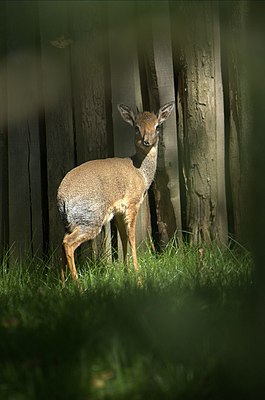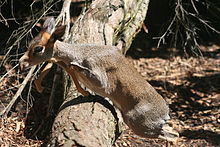Dikdiks
| Dikdiks | ||||||||||||
|---|---|---|---|---|---|---|---|---|---|---|---|---|

Kirk-Dikdik |
||||||||||||
| Systematics | ||||||||||||
|
||||||||||||
| Scientific name | ||||||||||||
| Madoqua | ||||||||||||
| Ogilby , 1837 |
The Dikdiks ( Madoqua ; also Dik-Diks ) are African dwarf antelopes that are only slightly larger than a hare . There are four types.
features
Depending on the species, the length of the head body varies between 50 and 70 cm, the shoulder height between 30 and 40 cm, and the weight between 3 and 7 kg. The top is gray or light brown in color, the bottom gray or white. Only the males have spear-like horns pointing backwards, but they are so short that they are often completely covered by long hairs forehead. This tuft of hair can be straightened up when excited. All dikdiks have a significantly longer snout than other goats; This development is particularly clear in the case of the tapir rams, which can move their snouts in all directions like a tapir . On both sides of the head, underneath the eye, there is a pre-eye gland that produces a black, sticky secretion.
distribution
Dikdiks inhabit dry steppes and semi-deserts. Your habitat must provide shrubs in which the antelopes can take cover. While all four species are common in a strip from Eritrea and Somalia to Tanzania , the Kirk-Dikdik is also found in Namibia. The two distribution areas are widely separated from each other.
Way of life
As animals that are active at night and at dusk, dikdiks live on leaves and grass, but also eat fruits, pods and flowers. Dikdiks usually do not need drinking water, as their food contains sufficient water and they can also absorb liquid through drops of dew on grass and leaves. The animals very often look for salt licks or ingest sand and chew on bones in order to get the necessary minerals. Due to their small size and color, they can hardly be seen in their habitat. They are shy and run away in a zigzag course at the slightest disturbance, giving off a loud alarm call.
Unlike other antelopes, dikdiks live in pairs that stay together for a lifetime. The males are responsible for defending the territory, which can be five to twenty hectares in size. Territorial fights occur rather rarely and when they do, only under goats. Dikdik goats mark their territory by means of dung heaps, whereby they cover the dung of their female partner with their own. Dikdiks also distribute their secretion from the pre-eye glands on twigs and grass stalks for marking. Dikdik couples spend around two thirds of their time together.
Reproduction
The mating seasons in East Africa are in May and November, in Southwest Africa in July / August and January / February. Twice a year a fawn is born after a 6-month gestation period. The young animal weighs 500 to 800 g at birth and is suckled for 3 to 4 months. The animals become sexually mature at about 6 to 9 months and at about 8 months the father drives the young animal out of his territory.
It is believed that all dikdiks have comparable ways of life.
Natural enemies
Dikdiks are hunted by almost all African predators: leopards , cheetahs , jackals , eagles and baboons , but also monitor lizards and giant snakes are among their enemies. Due to his vigilance and the high escape speed (over 40 km / h) a dikdik can often escape his persecutors.
Names and subdivisions
The term "dikdik" is onomatopoeic and is intended to reproduce the alarm call, which sounds something like "dsik-dsik", that these antelopes utter on the run. The scientific name Madoqua , on the other hand, is derived from medaqqwa , the Amharic name of the Dikdiks.
According to Colin Peter Groves and Peter Grubb 2011, the genre is structured as follows:
- Subgenus Greyhound antelopes ( Madoqua ), also Madoqua saltiana group:
- Harar-Dikdik or Rotbauchdikdik ( Madoqua hararensis Neumann , 1904)
- Lawrance-Dikdik ( Madoqua lawrancei Deake-Brockmann , 1926)
- Red-bellied Dikdik ( Madoqua phillipsi Thomas , 1894)
- Silberdikdik ( Madoqua piacentinii Drake-Brockmann , 1911)
- Eritrea Dikdik ( Madoqua saltiana ( Desmarest , 1817))
- Kleindikdik ( Madoqua swaynei Thomas , 1894)
- Subgenus Tapirbock ( Rhynchotragus ), also Madoqua kirkii group:
- Cavendish-Dikdik ( Madoqua cavendishi Thomas , 1898)
- Damara-Dikdik ( Madoqua damarensis ( Günther , 1880))
- Günther-Dikdik ( Madoqua guentheri Thomas , 1894)
- Hinde-Dikdik ( Madoqua hindei Thomas , 1902)
- Kirk-Dikdik ( Madoqua kirkii ( Günther , 1880))
- Smith-Dikdik ( Madoqua smithii Thomas , 1901)
- Thomas-Dikdik ( Madoqua thomasi ( Neumann , 1905))
Originally, Madoqua and Rhynchotragus were considered to be separate genera, the former being longer- snouted and having a significantly longer nasal bone and a median jawbone . However, both genera are morphologically so similar that they were ultimately united. The Kirk-Dikdik is a flock of species consisting of at least four separate species. Scientists first became aware of this through the sterile male offspring of crossed individuals in zoo animals. Cytogenetic studies from the 1960s onwards also revealed various karyotypes in Kirk-Dikdiks of East African origin. Analyzes of wild animals from Namibia in the mid-1990s then confirmed the presence of different sets of chromosomes in the Kirk and Damara dikdik, from which it was concluded that both may form twin species . Further genetic investigations then divided the Kirk dikdik into four types in the transition to the 21st century, namely into the Kirk, Damara, Cavendish and Thomas dikdik. Individual anatomical differences could also be worked out. In their revision of the hornbeams from 2011, Groves and Grubb finally divided the Kirk dikdik into five species, whereby in addition to the four already examined, they also raised the Hinde dikdik at species level.
The term “greyhound antelopes” is sometimes applied to all dikdiks; In addition, the English spelling Dik-dik is increasingly found in German texts .
Threat and protection
The local population has often hunted dikdiks because their meat and skin are in great demand. The hide is processed into leather, which comes on the market with the confusing name "Gazelle leather". Dikdiks, on the other hand, are said to be unpopular with big game hunters, as they also warn other animals by their stormy run away and their alarm calls and also move them to flee. On the run, dikdiks repeatedly give a loud whistle through their noses as an alarm call. The noise generated sounds something like the onomatopoeic name Dikdik derived from it.
The IUCN only lists the silver dikdik as endangered. It lives exclusively in Somalia , where it cannot be reached for the protection of species due to the broken political situation. Its current status is largely unknown.
literature
- Colin P. Groves and David M. Leslie Jr .: Family Bovidae (Hollow-horned Ruminants). In: Don E. Wilson and Russell A. Mittermeier (eds.): Handbook of the Mammals of the World. Volume 2: Hooved Mammals. Lynx Edicions, Barcelona 2011, ISBN 978-84-96553-77-4 , pp. 653-656
- CA Spinage: The Natural History of Antelopes. Croom Helm, London 1986, ISBN 0-7099-4441-1 .
Individual evidence
- ↑ a b Jonathan Kingdon, David Happold, Michael Hoffmann, Thomas Butynski, Meredith Happold and Jan Kalina (eds.): Mammals of Africa Volume VI. Pigs, Hippopotamuses, Chevrotain, Giraffes, Deer and Bovids. Bloomsbury, London, 2013, pp. 319–337
- ↑ a b c Steven C. Kingwood and Arlene T. Kumamoto: Madoqua guentheri. Mammalian Species 539, 1996, pp. 1-10
- ↑ a b c d Steven C. Kingwood and Arlene T. Kumamoto: Madoqua kirkii. Mammalian Species 569, 1997, pp. 1-10
- ^ A b Colin P. Groves and David M. Leslie Jr .: Family Bovidae (Hollow-horned Ruminants). In: Don E. Wilson and Russell A. Mittermeier (eds.): Handbook of the Mammals of the World. Volume 2: Hooved Mammals. Lynx Edicions, Barcelona 2011, ISBN 978-84-96553-77-4 , pp. 653-656
- ↑ Peter NM Brotherton, Josephine M. Pemberton, Petr E. Komers, Gavin Malarky: Genetic and behavioral evidence of monogamy in a mammal, Kirk's dik-dik (Madoqua kirkii). Proceedings of the Royal Society, Biological Sciences 264 (1382), 1997, pp. 675-681 doi : 10.1098 / rspb.1997.0096 , PMC 1688408 (free full text, PDF), PMID 9178540 .
- ^ African Wildlife Foundation: Dikdik , accessed February 12, 2013.
- ^ A b Colin Groves and Peter Grubb: Ungulate Taxonomy. Johns Hopkins University Press, 2011, pp. 1-317 (pp. 108-280)
- ↑ Arlene T. Kumamoto, Steven C. Kingswood and Wouter Hugo: Chromosomal divergence in allopatric populations of Kirk's Dikdik, Madoqua kirki (Artiodactyla, Bovidae). Journal of Mammology 75 (2), 1994, pp. 357-364
- ^ Fenton PD Cotterill: Species concepts and the real diversity of antelopes. In: A. Plowman (Ed.): Ecology and Conservation of Mini-antelope: Proceedings of an International Symposium on Duiker and Dwarf Antelope in Africa. Fuerth. 2003, pp. 59-118


